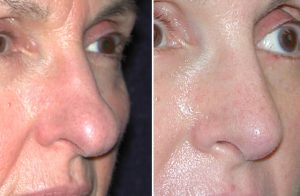Rhinoplasty is always stated to be about achieving a better balance or match of the shape of the nose to the rest of the face. That certainly sounds like a good goal but what does it exactly mean? As a plastic surgeon, this refers to changing or creating specific angles, measurements and lines of various nasal structures. Patients however are more interested in its overall appearance and, most importantly, a natural-looking result.

One of the well known signs of an unnatural rhinoplasty is a bridge that is too low. When a line between the top of the nose down to the tip is not straight and dips inward, this is known as a saddle nose deformity. Too aggressive removal of a hump composed of bone and cartilage is the cause. Weakening or loss of the internal support of the septum can also contribute to this same problem. Rhinoplasties of old were famous for having a scooped-out appearance to the nose…not to mention the eventual breathing difficulties. A straight dorsal line signifies good nasal support.
Two features of the nasal tip are dead giveaways for having an overdone rhinoplasty…the tip of the nose that is lifted up too high or tilted back too far and the tip of the nose that is too narrow or pointy. This is synonymous with loss of septal or lower alar cartilage support. Nostril deformities and asymmetries are common with each tip deformity. When the tip is too high, too much nostril exposure is seen. When the nasal tip is too narrow or a ‘unitip’, the nostrils often get a pinched look as its sidewalls bend inward. Interestingly, these tip deformities are more common today with the open approach which allows more extensive manipulation…sometimes too much.
Natural rhinoplasty is mostly about rearranging nasal structures rather than simply removing them. In this way, the nasal dorsal line remains straight but at a good height, the end of the nose is lifted if needed but not too high, and the tip of the nose is narrowed but is not made into a single point.Besides less cartilage and bone removal, the natural rhinoplasty makes use of adding support through cartilage grafts. Supporting the tip of the nose through columellar strut grafts, using small hand-carved grafts to improve tip shape, spreader cratilage grafts in the middle of the nose to open up breathing, and actually increasing the height and line of the nose through onlay or radix grafts are some of the methods by which the nose can be builtup and strengthened. These cartilage grafts are usually acquired from the septum of the nose (which may be simultaneously straightened) or from the back of the ear. Use of these maneuvers during a primary rhinoplasty will lessen the chance of the need for revisional surgery later.
What makes a rhinoplasty natural, for the most part, is to avoid the ‘operated’ appearance. Such appearances are from aggressive rhinoplasty maneuvers. While every patient wants a perfect result, most would choose a less noticeable more conservative result as an alternative if need be.
Dr. Barry Eppley
Indianapolis, Indiana


